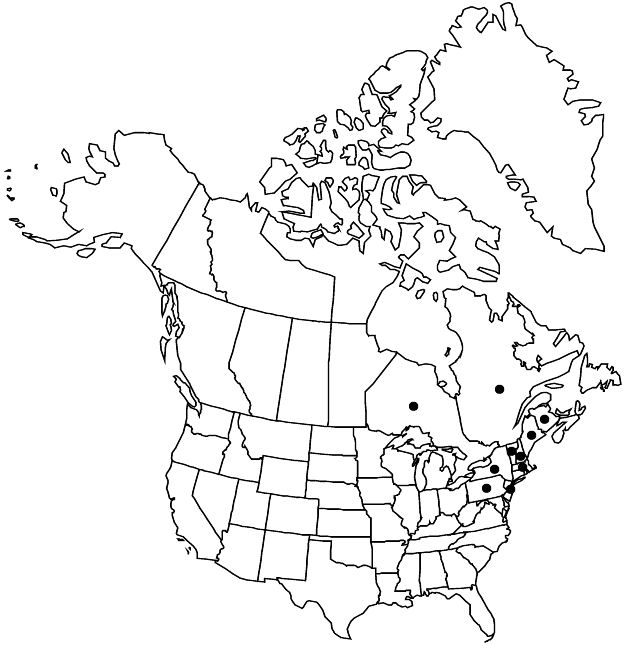Difference between revisions of "Prunus pumila var. depressa"
Trees Shrubs Brit. Isles 2: 249. 1914.
FNA>Volume Importer |
FNA>Volume Importer |
||
| Line 31: | Line 31: | ||
|elevation=10–200 m | |elevation=10–200 m | ||
|distribution=N.B.;Ont.;Que.;Maine;Mass.;N.H.;N.J.;N.Y.;Pa.;Vt. | |distribution=N.B.;Ont.;Que.;Maine;Mass.;N.H.;N.J.;N.Y.;Pa.;Vt. | ||
| − | |discussion=<p>Variety depressa always has prostrate to decumbent stems, and the plants form mats on the rocky or sandy substrate along streams in eastern North America. All of the other varieties sometimes have decumbent stems; specimens are sometimes misidentified as var. depressa, but nearly always some of the stems on these plants are ascending or erect. Stems of vars. besseyi and pumila are often partially buried in shifting sands on the dunes in the sandhills of Nebraska and on the dunes along the shores of the Great Lakes.</p> | + | |discussion=<p>Variety depressa always has prostrate to decumbent stems, and the plants form mats on the rocky or sandy substrate along streams in eastern North America. All of the other varieties sometimes have decumbent stems; specimens are sometimes misidentified as <i></i>var.<i> depressa</i>, but nearly always some of the stems on these plants are ascending or erect. Stems of vars. besseyi and pumila are often partially buried in shifting sands on the dunes in the sandhills of Nebraska and on the dunes along the shores of the Great Lakes.</p> |
|tables= | |tables= | ||
|references= | |references= | ||
| Line 55: | Line 55: | ||
|publication year=1914 | |publication year=1914 | ||
|special status=Endemic | |special status=Endemic | ||
| − | |source xml=https://jpend@bitbucket.org/aafc-mbb/fna-data-curation.git/src/ | + | |source xml=https://jpend@bitbucket.org/aafc-mbb/fna-data-curation.git/src/8f726806613d60c220dc4493de13607dd3150896/coarse_grained_fna_xml/V9/V9_619.xml |
|subfamily=Rosaceae subfam. Amygdaloideae | |subfamily=Rosaceae subfam. Amygdaloideae | ||
|tribe=Rosaceae tribe Amygdaleae | |tribe=Rosaceae tribe Amygdaleae | ||
Revision as of 18:18, 18 September 2019
Stems prostrate to decumbent, 1–5 dm; twigs glabrous. Leaf blades oblanceolate, 3.9–7.5 × 1–2(–2.3) cm, lengths ca. 3.7 times widths, base long-attenuate, apex obtuse to acute. Drupes broadly ellipsoid, 6–10 × 3–7 mm; stones ovoid to fusiform, 6–8.5 × 4.5–5 mm.
Phenology: Flowering May–Jun; fruiting Aug.
Habitat: Rocky, gravelly, or sandy shores or bars of streams and lakes
Elevation: 10–200 m
Distribution

N.B., Ont., Que., Maine, Mass., N.H., N.J., N.Y., Pa., Vt.
Discussion
Variety depressa always has prostrate to decumbent stems, and the plants form mats on the rocky or sandy substrate along streams in eastern North America. All of the other varieties sometimes have decumbent stems; specimens are sometimes misidentified as var. depressa, but nearly always some of the stems on these plants are ascending or erect. Stems of vars. besseyi and pumila are often partially buried in shifting sands on the dunes in the sandhills of Nebraska and on the dunes along the shores of the Great Lakes.
Selected References
None.